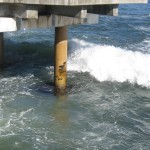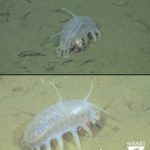The otters our class saw on our field trip to Monterey Bay were awfully cute. But I have to admit there was a piece of my former engineer’s heart that was touched, not by the furry faces, but by the antennas, radio transmitters, temperature and depth recorders, and GPS computers the scientists showed us. The sensors were used to identify individual otters and record their location, but could also tell researchers whether an animal was alive or dead and the type of activity it might be engaging in. Fast paced beeps meant a radio transmitter was in a warm location (most likely inside of a live animal). If the fast paced beeps were interrupted with periods of silence, the otter could be diving to forage for food. Uninterrupted beeping usually indicated the otter was resting on the surface of the water.
I think the work engineers do in designing scientific instruments is incredibly important, and the Montery Bay Aquarium Research Institute seems to agree. Look below for a picture of one of the MBARI engineers’ cool projects.

The remotely operated vehicle (ROV) Doc Ricketts goes for a test drive in Monterey Bay. Source: MBARI (http://www.mbari.org/news/homepage/2009/rov-ricketts.html)
ROVs aid scientists by, among other things, capturing amazing videos of otherworldly deep-sea creatures:







Comments are closed.